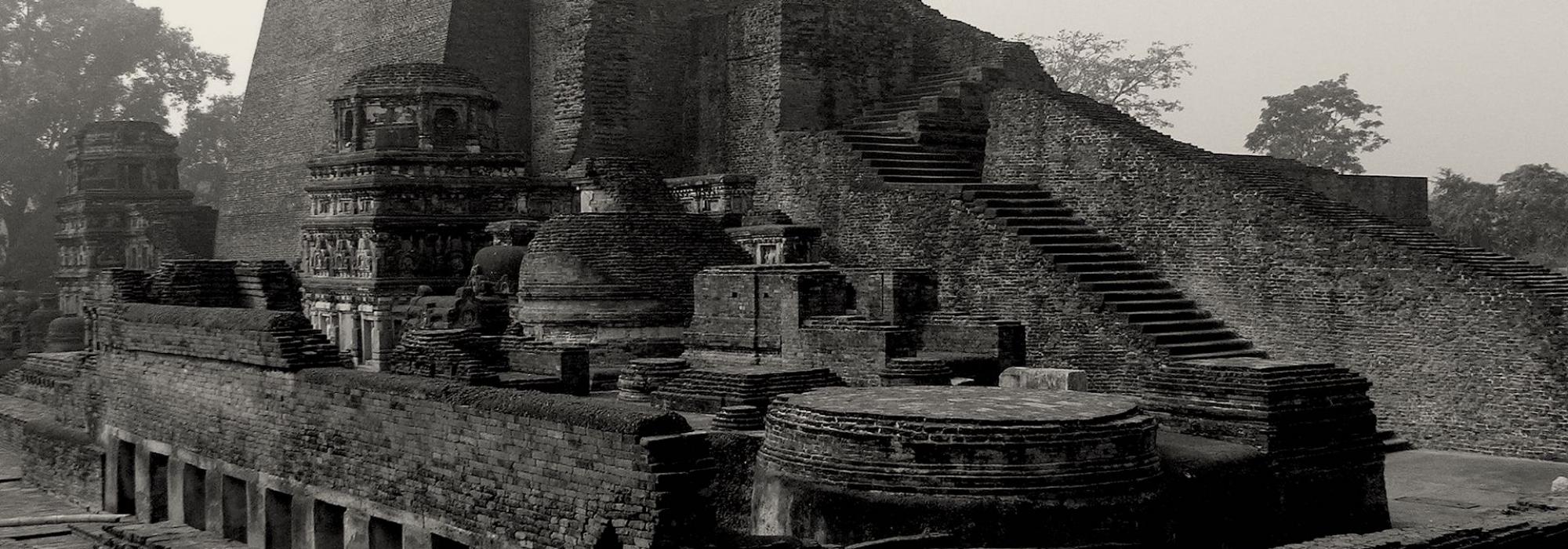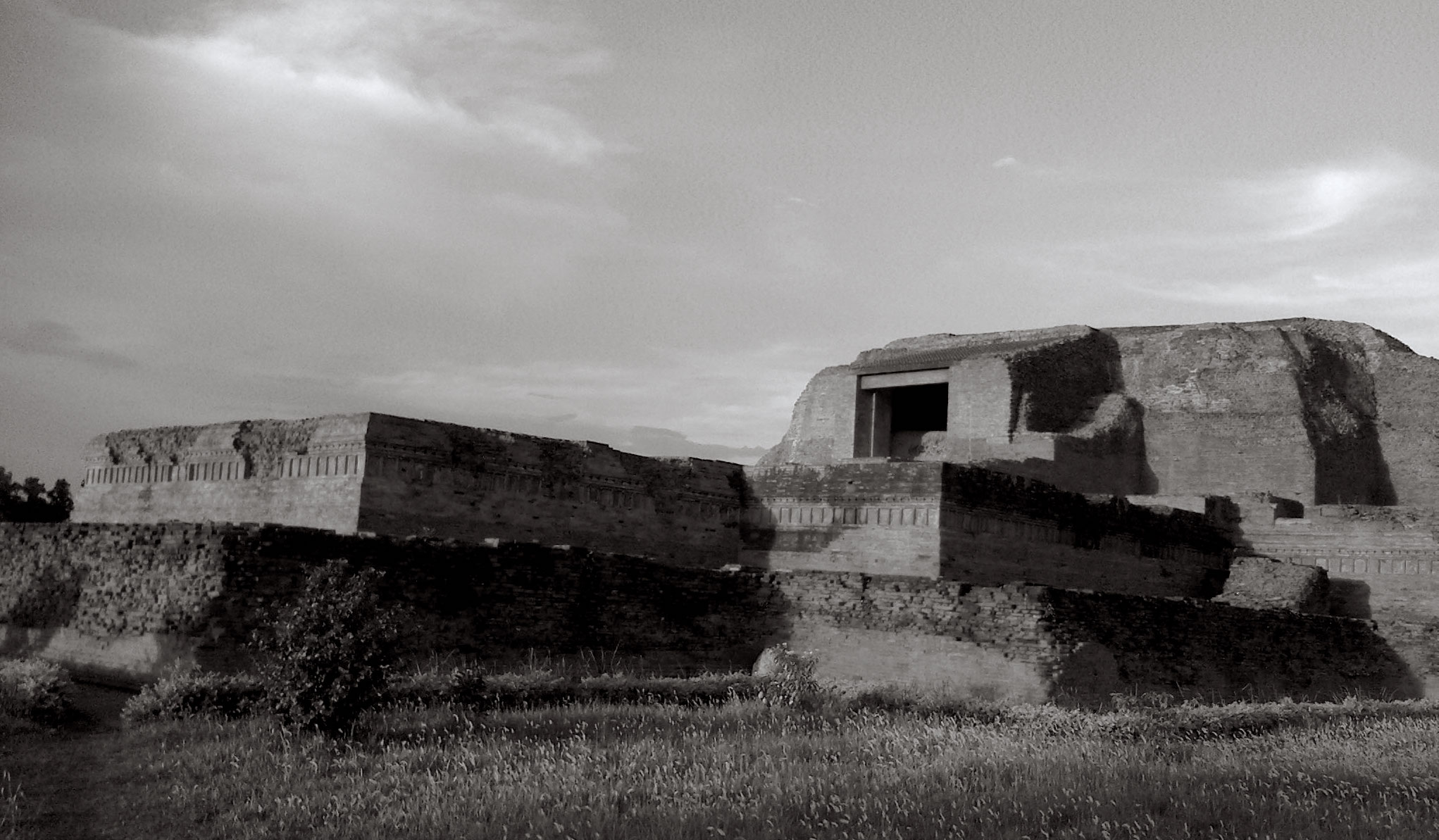After Maharaja Shashanka, for a long period of around one hundred years, Bengal was without a ruler. With a view to remedy the situation, the local chieftains—large and small—seem to have come together and elected one among them as their supreme leader, solely keeping in mind the welfare of the people. The fruit that resulted from these actions is the great lineage of the Palas. This is indeed one of the great traits of the noble values of kṣātra seen in the Indian tradition. The Pala lineage pinnacles are represented by Dharmapala and his son Devapala. This father-son duo ruled for about eighty years (770–810 CE and 810–850 CE).
Dharmapala immensely benefitted from the war between the Rashtrakutas and the Pratiharas. Dharmapala escaped from the attack by King Vatsaraja of the Pratiharas and in course of time he captured Kānyakubja (Kannauj). We can see his political acumen from how he achieved this feat. While the Palas were centred in modern-day Bengal and Bihar, they also ruled over large parts of Punjab, Rajasthan, Malwa, and Uttar Pradesh; for at least some time, the Pala king was hailed as an uttarāpatheśvara – the lord of the northern lands. Dharmapala gained fame as a king who had won a hundred wars. The strength and dexterity of his navy were limitless. The infantry (with elephants) and the cavalry (with horses) in his army were large and powerful. He is also the visionary responsible for establishing the Vikramaśīla and Odantapuri universities.
Just like his father, Devapala too was a great warrior, full of valour. He further expanded the kingdom that his father had established and ruled over those lands. The boundaries of his vast kingdom were Kambhoja in the west [in modern-day Pakistan], the Vindhya mountain range in the south, the Himalayas in the north, and the sea in the east [modern-day Bay of Bengal]. Although he waged wars and won against three generations of the Pratihara kings, he could not defeat the Rashtrakutas, who were a powerful royal dynasty of that period. However, it is also true that by Devapala’s time, the Rashtrakutas had lost all hopes of winning territories in the North Indian region. Devapala, who was skilled in managing a large army, emerged victorious merely by his brilliant war strategy. The Arab trader Suleiman says that the strength and discipline of Devapala’s vast army were admirable; there were apparently fifteen thousand washermen dedicated to cleaning the army uniforms of the soldiers! Devapala had an infantry unit that comprised fifty-thousand elephants.
Although the Pala kings where adherents of Buddhism, in the early years of their dynasty, they had internalized the fundamental values of Sanātana Dharma. They had realized the importance of kṣātra. They generously donated to Nalanda and other universities, which were centres of Buddhist learning. They encouraged and befriended the numerous Buddhist kings and scholars coming from within and outside the country. Yet they ruled over a large population of citizens who adhered to Sanātana Dharma. They never tried to convert the citizens to Buddhism nor did they force Buddhist precepts on them. Not only that, it appears that the Pala kings established various centres of worship for multiple Hindu deities.
Today we don’t find any large temples or centres of worship constructed by the Palas. The definitive reason for this is the blood-stained and abhorrent journey undertaken by Bhaktiyar Khilji and other countless Muslim invaders who destroyed thousands of Hindu temples with a vengeance. What we see of the Palas today are just ruins – a few remains of sculptures and some images and pictures that are that have been preserved and protected in various museums in India and abroad. For instance, the sculpture of Viṣṇu sitting on Garuḍa, Ardhanārīśvara, Kalyāṇasundara, Gaṅgā-Yamunā, and many others. These are all clearly symbols of Sanātana Dharma.
Further, we learn that several Sanskrit poets and Sanātana Dharmis like Abhinanda (composer of Rāmacarita, a long and beautiful poem that closely follows the Vedic tradition), Yogeśvara, Vasukalpa, and Keṣaṭa obtained nourishment from the Palas for their art. The wonderful poems composed by these great poets stands testimony to the generosity and magnanimity of the Palas. As we have mentioned earlier, it becomes evident that the early Pala kings were admirers of Sanātana Dharma. Therefore, the all-round prosperity of the kingdom of Dharmapala and Devapala was firmly established with a solid foundation.
However, the Pala kings who followed, like Vigrahapala, Narayanapala, and others became weak, powerless, and dull. They began adhering to self-contradictory, distorted, and corrupted Buddhist sects such as Sahajayāna, Vajrayāna, and Mahācīna. These sects totally lacked the enthusiasm of Sanātana Dharma and propagated nirāśāvāda (doctrine of despair) and misplaced ahiṃsā, bringing disgust to people and causing a great deal of trouble to the world at large. As a result, the kingdom had to face a lot of difficulty, having strayed from the path of kṣātra – this naturally led to a depletion of prosperity of the kingdom and robbed the joy of its citizens.
This morbid tale serves as a warning to all generations.
After ruling for three or four years, Maharaja Vigrahapala became a Buddhist bhikku (monk). And as for Narayanapala, he was immersed in contemplation about Buddhist philosophy throughout his fifty-year reign of inaction and aloofness. Through his, he ensured that the Pala dynasty would have no future. He became a menace to his own people, coming in the way of their pursuits of the trivarga – dharma, artha, and kāma. It was during his reign that the Pratiharas defeated them and annexed large parts of the Pala kingdom. This went to such an extent that North Bengal, which was the centre of the Palas and the land of their origin, came within the reach of the Pratihara king Mahendrapala. Along with this, the vassals of the Pala Empire, which included the rulers of Kamarupa (Assam), Kalinga (Odisha), and Manipura threw off the Pala yoke and declared themselves independent.
All this was the heinous fruit of the Palas abandoning kṣātra. Finally with the help from the Rashtrakutas, Narayanapala was able to regain some stability but that became a sort of submission and slavery. The Pala dynasty saw further decline with the advent of Narayanapala’s successors – Rajyapala and Gopala II. They were vanquished in battle by the Chandellas and Kalachuryas. We learn that later on, Mahipala, the son of Vigrahapala II, reinvigorated kṣātra and took Bengal back into his grip, establishing stability there, firmly settling down in his homeland.
After that the Senas from Karnataka became a strong force in eastern India. Therefore, just as we have seen earlier, treading the path of the great kings Ashoka, Kanishka, and Harshavardhana, the Palas too abandoned kṣātra and paid a heavy price for it.
It would not be incorrect if we claim that the history of the Palas serves as an invaluable political lesson not just to India but to any nation of the world.
To be continued Translated from Kannada by Hari Ravikumar and Sandeep Balakrishna

















































